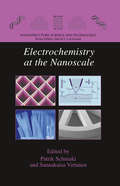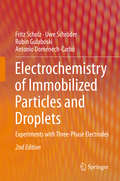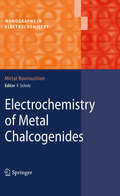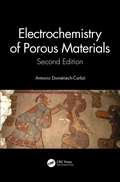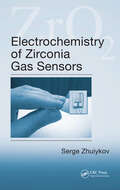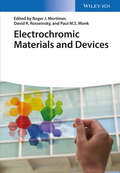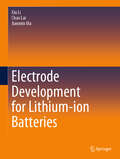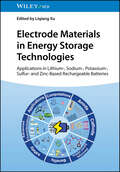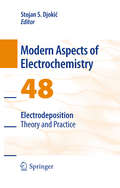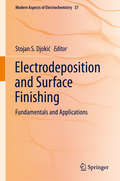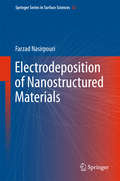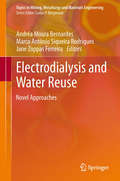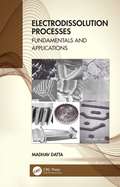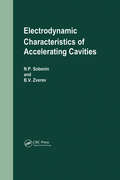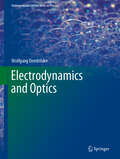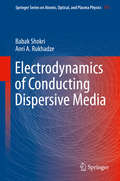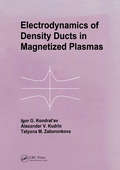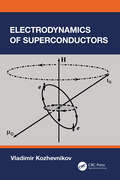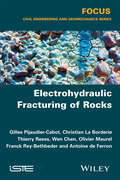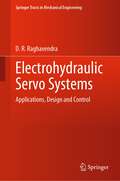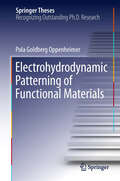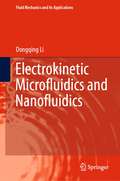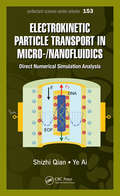- Table View
- List View
Electrochemistry at the Nanoscale
by Patrik Schmuki Sannakaisa VirtanenFor centuries, electrochemistry has played a key role in technologically important areas such as electroplating or corrosion. In recent decades, electrochemical methods are receiving increasing attention in important strongly growing fields of science and technology such as nanosciences (nanoelectrochemistry) and life-sciences (organic and biological electrochemistry). Characterization, modification and understanding of various electrochemical interfaces or electrochemical processes at the nanoscale, has led to a huge increase of the scientific interest in electrochemical mechanisms as well as of application of electrochemical methods in novel technologies. This book presents exciting emerging scientific and technological aspects of the introduction of the nanodimension in electrochemical approaches are presented in 12 chapters/subchapters.
Electrochemistry for the Environment
by Christos Comninellis Guohua ChenThe book starts with the fundamentals of environmental electrochemistry, introducing the basic techniques in selecting and fabricating electrode materials, followed by a theoretical analysis of the electrochemical processes, green electrochemical operation, discussion of electrochemical technologies in water treatment, and then examination of the established wastewater treatment technologies such as electrochemical reactors for metal recovery, electrocoagulation, electroflotation and electrooxidation. Emerging technologies such as electrophotooxidation, electro disinfection, and electrochemical technologies in sludge and soil treatment will also be analyzed. This book will be an excellent reference for young researchers starting new research programs and also for industrialists who wish to appreciate the technologies.
Electrochemistry of Immobilized Particles and Droplets
by Fritz Scholz Uwe Schröder Rubin Gulaboski Antonio Doménech-CarbóThis second edition of a successful and highly-accessed monograph has been extended by more than 100 pages. It includes an enlarged coverage of applications for materials characterization and analysis. Also a more detailed description of strategies for determining free energies of ion transfer between miscible liquids is provided. This is now possible with a "third-phase strategy" which the authors explain from theoretical and practical points of view. The book is still the only one detailing strategies for solid state electroanalysis. It also features the specific potential of the techniques to use immobilized particles (for studies of solid materials) and of immobilized droplets of immiscible liquids for the purpose of studying the three-phase electrochemistry of these liquids. This also includes studies of ion transfer between aqueous and immiscible non-aqueous liquids. The bibliography of all published papers in this field of research has been expanded from 318 to now 444 references in this second edition. Not only are pertinent references provided at the end of each chapter, but the complete list of the cited literature is also offered as a separate chapter for easy reference.
Electrochemistry of Insertion Materials for Hydrogen and Lithium
by Joo-Young Go Su-Il Pyun Jong-Won Lee Heon-Cheol ShinThe understanding of hydrogen/lithium insertion phenomena is of great importance for the development of the next generation of functional electrochemical devices such as rechargeable batteries, electrochromic devices, and fuel cells. This volume introduces a variety of viable electrochemical methods to identify reaction mechanisms and evaluate relevant kinetic properties of insertion electrodes. The authors also outline various ways to analyze anomalous behaviour of hydrogen/lithium transport through insertion electrodes.
Electrochemistry of Metal Chalcogenides
by Mirtat BouroushianThe author provides a unified account of the electrochemical material science of metal chalcogenide (MCh) compounds and alloys with regard to their synthesis, processing and applications. Starting with the chemical fundamentals of the chalcogens and their major compounds, the initial part of the book includes a systematic description of the MCh solids on the basis of the Periodic Table in terms of their structures and key properties. This is followed by a general discussion on the electrochemistry of chalcogen species, and the principles underlying the electrochemical formation of inorganic compounds/alloys. The core of the book offers an insight into available experimental results and inferences regarding the electrochemical preparation and microstructural control of conventional and novel MCh structures. It also aims to survey their photoelectrochemistry, both from a material-oriented point of view and as connected to specific processes such as photocatalysis and solar energy conversion. Finally, the book illustrates the relevance of MCh materials to various applications of electrochemical interest such as (electro)catalysis in fuel cells, energy storage with intercalation electrodes, and ion sensing.
Electrochemistry of Porous Materials
by Antonio Doménech CarbóElectrochemistry of Porous Materials describes essential theoretical aspects of the electrochemistry of nanostructured materials and primary applications, incorporating the advances in the field in the last ten years including recent theoretical formulations and the incorporation of novel materials. Concentrating on nanostructured micro- and mesoporous materials, the highly anticipated Second Edition offers a more focused and practical analysis of key porous materials considered relatively homogeneous from an electrochemical point of view. The author details the use of electrochemical methods in materials science for characterization and their applications in the fields of analysis, energy production and storage, environmental remediation, and the biomedical arena. Additional features include: Incorporates new theoretical advances in the voltammetry of porous materials and multiphase porous electrochemistry. Includes new developments in sensing, energy production and storage, degradation of pollutants, desalination and drug release. Describes redox processes for different porous materials, assessing their electrochemical applications. Written at an accessible and understandable level for researchers and graduate students working in the field of material chemistry. Selective and streamlined, Electrochemistry of Porous Materials, Second Edition culls a wide range of relevant and practically useful material from the extensive literature on the subject, making it an invaluable reference for readers of all levels of understanding.
Electrochemistry of Zirconia Gas Sensors
by Serge ZhuiykovThe first book to present a detailed analysis of the electrochemistry, development, modeling, optimization, testing, and technology behind modern zirconia-based sensors, Electrochemistry of Zirconia Gas Sensors explores how to tailor these sensors to meet specific industrial needs. The book addresses a range of different stages of development in zi
Electrochromic Materials and Devices
by Roger J. Mortimer David R. Rosseinsky Paul M. S. MonkElectrochromic materials can change their properties under the influence of an electrical voltage or current. Different classes of materials show this behavior such as transition metal oxides, conjugated polymers, metal-coordinated complexes and organic molecules. As the color change is persistent, the electric field needs only to be applied to initiate the switching, allowing for applications such as low-energy consumption displays, light-adapting mirrors in the automobile industry and smart windows for which the amount of transmitted light and heat can be controlled. The first part of this book describes the different classes and processing techniques of electrochromic materials. The second part highlights nanostructured electrochromic materials and device fabrication, and the third part focuses on the applications such as smart windows, adaptive camouflage, biomimicry, wearable displays and fashion. The last part rounds off the book by device case studies and environmental impact issues.
Electrode Development for Lithium-ion Batteries
by Xiu Li Jianmin Ma Chao LaiThe field of new energy batteries is a major national strategy and a hot spot for research and development. Particular attention is paid to battery technology and electrode materials. In recent years, the importance of electrolytes has become increasingly prominent, but there is still a long way to go for practitioners to train in this field, mainly due to their lack of knowledge and technology. It is in this context that the book was planned and designed. The main feature and advantage of the book is that the author combines academic and practical work according to his own industry and scientific research experience, which is also an important advantage of the book. It is expected that this book will have important guiding value for graduate students in the field of electrochemistry in universities and technicians in battery companies. The translation was done with the help of artificial intelligence. A subsequent human revision was done primarily in terms of content.
Electrode Materials in Energy Storage Technologies: Applications in Lithium-, Sodium-, Potassium-, Sulfur- and Zinc-Based Rechargeable Batteries
by Liqiang XuDiscover the necessary materials for building better and cheaper batteries for a sustainable future The search for renewable energy sources is one of the most vital steps towards a sustainable future. The rapid development of new energy technology has placed considerable pressure on the production of rechargeable batteries in recent years. Electrode materials, which provide the “heart” of the rechargeable battery, are therefore necessarily the focus of any efforts to produce cheaper, more and more sustainable battery-powered systems. Electrode Materials in Energy Storage Technologies provides a comprehensive overview of all key electrode materials for rechargeable batteries. Beginning with an introduction to rechargeable battery technology, it moves to analysis of specific systems. Complete with an in-depth understanding of essential electrochemical mechanisms, it’s an indispensable guide to a core aspect of the ongoing energy revolution. Electrode Materials in Energy Storage Technologies readers will also find: A focus on design, structure-property relationships, and applications of electrode materials Detailed discussion of materials including lithium, sodium, potassium, zinc, and more Numerous practical applications with an emphasis on safety, sustainability, and market trends Electrode Materials in Energy Storage Technologies is ideal for material scientists and chemists of all kinds.
Electrodeposition
by Stojan S. DjokicIn the past few decades, research in the science of electrodeposition of metals has shown the important practical applications of electronic, magnetic, energy devices and biomedical materials. The aim of this new volume is to review the latest developments electrodeposition and present them to teachers, professionals, and students working in the field.
Electrodeposition and Surface Finishing
by Stojan S. DjokićThis volume of Modern Aspects of Electrochemistry has contributions from significant individuals in electrochemistry. This 7 chapter book discusses electrodeposition and the characterization of alloys and composite materials, the mechanistic aspects of lead electrodeposition, electrophoretic deposition of ceramic materials onto metal surfaces and the fundamentals of metal oxides for energy conversion and storage technologies. This volume also has a chapter devoted to the anodization of aluminum, electrochemical aspects of chemical and mechanical polishing, and surface treatments prior to metallization of semiconductors, ceramics, and polymers. This volume of Modern Aspects of Electrochemistry is ideal for scientists, researchers, engineers, and students interested in the latest findings in the field of electrodeposition and surface finishing.
Electrodeposition of Nanostructured Materials
by Farzad NasirpouriThis book provides an overview of electrodeposition of nanomaterials from principles to modern concepts for advanced materials in science and technology. Electrochemical deposition or electrodeposition is explained for fabrication and mass production of functional and nanostructured device materials. The present book spans from principles to modern insights and concepts. It gives a comprehensive overview of the electrochemistry of materials, which is useful as basic information to understand concepts used for nanostructuring of electrodeposited materials, reviews the electrodeposition constituents, thermodynamics and kinetics of electrodeposition, electrochemical and instrumental assessment techniques and other physical factors affecting the electrodeposition mechanisms. A wide variety of nanostructured materials and related concepts and applications are explained with respect to nanocrystals, nanocrystalline films, template-based nanostructures, nanocomposite films, nanostructures on semiconductors, multilayers, mesoporous films, scanning microscopical probe assisted fabrication and galvanic replacement. This book is useful for researchers in materials science, engineering technologists and graduate students. It can also be used as a textbook for undergraduates and graduate students studying related disciplines.
Electrodialysis and Water Reuse
by Andréa Moura Bernardes Marco Antônio Siqueira Rodrigues Jane Zoppas FerreiraThis book presents novel techniques to evaluate electrodialysis processes, to synthesize ionic membranes and to characterize their properties. It shows the potential use of membrane process to the treatment of effluents generated in many industrial sectors such as refineries, leather industries, mining and electroplating processes. The book is based on the results obtained by the author's research group during the past decade. It is useful for students, researchers and engineers interested in membrane technologies for water reuse.
Electrodissolution Processes: Fundamentals and Applications
by Madhav DattaElectrodissolution Processes: Fundamentals and Applications discusses the basic principles involved in high-rate anodic dissolution processes and their application in advanced machining, micromachining, and finishing operations. The fundamentals section of the book discusses the anodic dissolution behavior of different classes of metals and the influence of mass transport, current distribution, and surface film properties on the metal removal rate and surface finishing. The applications section of the book presents essential elements of electrochemical and assisted techniques for precision machining, micromachining, and polishing of advanced materials, including hard-to-machine conducting ceramic materials. Features A first-of-its-kind book that provides updated scientific and engineering information related to high-rate anodic dissolution processes Highlights the importance of the understanding of basic principles required for designing and optimizing ECM/EMM/EP processes Gives equal emphasis to the fundamentals and applications of electrodissolution processes Discusses the high-rate anodic dissolution of two broad classes of materials, namely, engineering and refractory materials Presents case studies to demonstrate the capabilities of different electrochemical and assisted machining, micromachining, and finishing operations Presents a dedicated chapter on electrochemical planarization of copper interconnects Madhav Datta is the Chairman of Amrita Center for Industrial Research and Innovation and a Distinguished Professor in the Department of Chemical Engineering and Materials Science, Amrita University, Coimbatore, India.
Electrodynamic Characteristics of Accelerating Cavities
by N P Sobenin B V ZverevNow available for the first time in English translation, this important book contains extensive material relating to the electrodynamic characteristics of linear accelerators, and gives a good overview of the fundamentals of accelerating cavity design. The authors describe the experimental methods and measurement techniques essential in this area of research, and provide comprehensive data about the electrodynamic characteristics of resonant structures, which are widely used in charged particle accelerators and microwave devices. Single cavities and coupling chains, excited in electrical and magnetic modes, are described numerically and analyzed in detail. The book also provides a valuable description of the perturbation method, which is illustrated using a unique collection of data.
Electrodynamics and Optics (Undergraduate Lecture Notes in Physics)
by Wolfgang DemtröderThis engaging text offers an accessible and clear treatment of the fundamentals of electromagnetics and optics, a core part of the standard undergraduate physics curriculum. Starting with static electric and magnetic fields, the book works through electromagnetic oscillations and the formation and propagation of electromagnetic waves, before moving on to geometric and wave optics, optical instrumentation and some discussion of new technologies in optics. The text is written from the experimental physics point of view, giving numerous real life examples and applications of devices. This highly motivating presentation deepens the knowledge in a very accessible way, carefully interweaving theory and practical applications. Students are guided through the material with well-chosen examples and case studies, and helpful chapter summaries are provided together with numerous exercises and detailed solutions, all intended to motivate and develop a well-founded understanding of the subject matter.
Electrodynamics of Conducting Dispersive Media (Springer Series on Atomic, Optical, and Plasma Physics #111)
by Babak Shokri Anri A. RukhadzeThis book presents a sequential representation of the electrodynamics of conducting media with dispersion. In addition to the general electrodynamic formalism, specific media such as classical nondegenerate plasma, degenerate metal plasma, magnetoactive anisotropic plasma, atomic hydrogen gas, semiconductors, and molecular crystals are considered.The book draws on such classics as Electrodynamics of plasma and plasma-like media (Silin and Rukhadze) and Principles of Plasma Electrodynamics (Alexandrov, Bogdankevich, and Rukhadze), yet its outlook is thoroughly modern—both in content and presentation, including both classical and quantum approaches. It explores such recent topics as surface waves on thin layers of plasma and non-dispersive media, the permittivity of a monatomic gas with spatial dispersion, and current-driven instabilities in plasma, among many others. Each chapter is equipped with a large number of problems with solutions that have academic and practical importance. This book will appeal to graduate students as well as researchers and other professionals due to its straight-forward yet thorough treatment of electrodynamics in conducting dispersive media.
Electrodynamics of Density Ducts in Magnetized Plasmas: The Mathematical Theory of Excitation and Propagation of Electromagnetic Waves in Plasma Waveguides
by I G Kondratiev A V Kudrin T M ZaboronkovaProviding a systematic and self-contained treatment of excitation, propagation and re- emission of electromagnetic waves guided by density ducts in magnetized plasmas, this book describes in detail the theoretical basis of the electrodynamics of ducts. The classical dielectric-waveguide theory in open guiding systems in magnetoplasma is subjected to rigorous generalization. The authors emphasize the conceptual physical and mathematical aspects of the theory, while demonstrating its applications to problems encountered in actual practice. The opening chapters of the book discuss the underlying physical phenomena, outline some of the results obtained in natural and artificial density ducts, and describe the basic theory crucial to understanding the remainder of the book. The more specialized and complex topics dealt with in subsequent chapters include the theory of guided wave propagation along axially uniform ducts, finding the field excited by the source in the presence of a duct, excitation of guided modes, the asymptotic theory of wave propagation along axially nonuniform ducts, and mode re-emission from a duct. The full wave theory is used throughout most of the book to ensure consistency, and the authors start with simpler cases and gradually increase the complexity of the treatment.
Electrodynamics of Superconductors
by Vladimir KozhevnikovSuperconductivity is a remarkable, on the verge of miraculous, macroscopic quantum phenomenon with a boundless potential for a wide variety of applications. Over the last century the physics of superconductivity constitutes a major part of research in condensed matter and yet the electrodynamics of superconductors appears as only a minor part in textbooks on electrodynamics and superconductivity. The book offers a fresh look at electrodynamics of continuous media with detailed description of thermal and electromagnetic properties of superconductors, emphasising physical meaning of concepts and principles without excessive mathematics. To facilitate understanding, it is accompanied by problems and worked solutions. The book will be of interest to senior undergraduate and graduate students of physics and chemistry who have taken a calculus-based course in general physics. It is a valuable reference for researchers involved in studies of superconductivity, the physics of metals, and condensed matter physics.Key Features: The first book - in terms of semi-classical physics - addressing both equilibrium and nonequilibrium, thermal and transport properties of superconducting materials Presents an accessible overview without excessive mathematics Accompanied by problems with solutions to aid understanding
Electrohydraulic Fracturing of Rocks
by Gilles Pijaudier-Cabot Olivier Maurel Wen Chen Thierry Reess Antoine De Ferron Christian La Borderie Franck Rey-BerbederThis book presents a new fracturing technique that should be considered as a potential alternative, or a companion technique, to hydraulic fracturing of tight gas reservoirs and low permeability rock masses. As opposed to hydraulic fracturing which generates a few numbers of large cracks, electro-hydraulic fracturing induces diffuse micro-cracking and fragmentation of rocks. Laboratory tests demonstrate that increases of permeability by two orders of magnitude can be reached, without major cracking in tested specimens. This book discusses the principles of this new technique, reports experiments which have been developed is order to prove the concept and finally describes the numerical model from which the potentialities of this technique in representative reservoir conditions can be assessed.
Electrohydraulic Servo Systems: Applications, Design and Control (Springer Tracts in Mechanical Engineering)
by D. R. RaghavendraThis book covers the fundamental concepts of electrohydraulic (EH) servo systems in detail and also presents the developments about power, quadratic response, and control flexibility of EH servo systems with applications in aircraft/aerospace engineering, mobile equipment, material/structure testing, motion simulators, and strategic defense sectors. Various topics covered in this books are systems and configurations of servo systems, components, applications, design of SISO and MIMO and control options of SISO and MIMO systems. It further includes a chapter on contamination control, fault detection and diagnosis (FDD) of these systems. The detailed working procedures and advice on implementation routines presented in this book will help readers to apply the control models and systems presented so as to make their own servo systems more efficient. The book will be useful for mechanical engineers and professionals involved in the analysis and design of electrohydraulic control systems, especially in advanced hydraulic industries, the aeronautical and space, and automotive industries. It would also be a useful reference for advanced courses in EH systems.
Electrohydrodynamic Patterning of Functional Materials
by Pola Goldberg OppenheimerThis thesis explores a route to induce and control the structure formation process in thin films by the use of strong electric fields. We investigate, establish and apply the use of the electrohydrodynamic (EHD) lithography as a versatile patterning tool on the sub-micrometre and nanometre length scales for functional materials. Thin films are ubiquitous, they are found in nature and used in almost every aspect of daily life. While film instabilities are often undesirable in nature and technology, they can be utilized to produce structures by precisely controlling the destabilization of the film. EHD lithography utilizes instabilities induced by means of an electric field to fabricate periodic structures. EHD patterning is set to become a competitive candidate for low-cost lithographic technology for a number of applications. Herein, the applied potential of this lithographic process is explored by expanding its applicability to a broad range of materials and by a simultaneous patterning of multilayer systems or functional polymers yielding hierarchical architectures with novel functionalities. EHD pattern formation enables for instance, the fabrication of multi-scale structured arrays as surface enhanced Raman scattering (SERS)-active platforms. Furthermore, crystalline and conductive polymers are patterned using the EHD approach and the underlying structure formation mechanisms are discussed. This extension towards functional material systems offers interesting prospects for potential applications. Findings of this thesis are very promising for use in optoelectronic devices.
Electrokinetic Microfluidics and Nanofluidics (Fluid Mechanics and Its Applications #133)
by Dongqing LiThis book reviews the latest advancement of microfluidics and nanofluidics with a focus on electrokinetic phenomena in microfluidics and nanofluidics. It provides fundamental understanding of several new interfacial electrokinetic phenomena in microfluidics and nanofluidics. Chapter 1 gives a brief review of the fundamentals of interfacial electrokinetics. Chapter 2 shows induced charge electrokinetic transport phenomena. Chapter 3 presents the new advancement in DC dielectrophoresis. Chapter 4 introduces a novel nanofabrication method and the systematic studies of electrokinetic nanofluidics. Chapter 5 presents electrokinetic phenomena associated with Janus particles and Janus droplets. Chapter 6 introduces a new direction of electrokinetic nanofluidics: nanofluidic iontronics. Chapter 7 discusses an important differential resistive pulse sensor in microfluidics and nanofluidics.
Electrokinetic Particle Transport in Micro-/Nanofluidics: Direct Numerical Simulation Analysis (Surfactant Science)
by Shizhi Qian Ye AiNumerous applications of micro-/nanofluidics are related to particle transport in micro-/nanoscale channels, and electrokinetics has proved to be one of the most promising tools to manipulate particles in micro/nanofluidics. Therefore, a comprehensive understanding of electrokinetic particle transport in micro-/nanoscale channels is crucial to the
